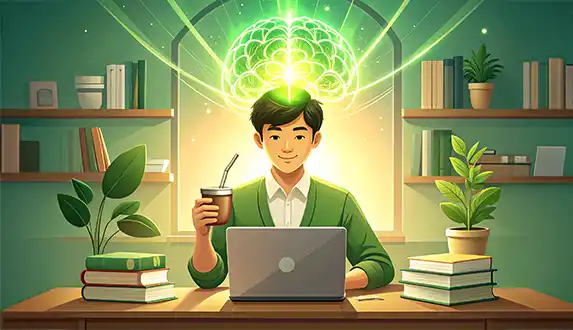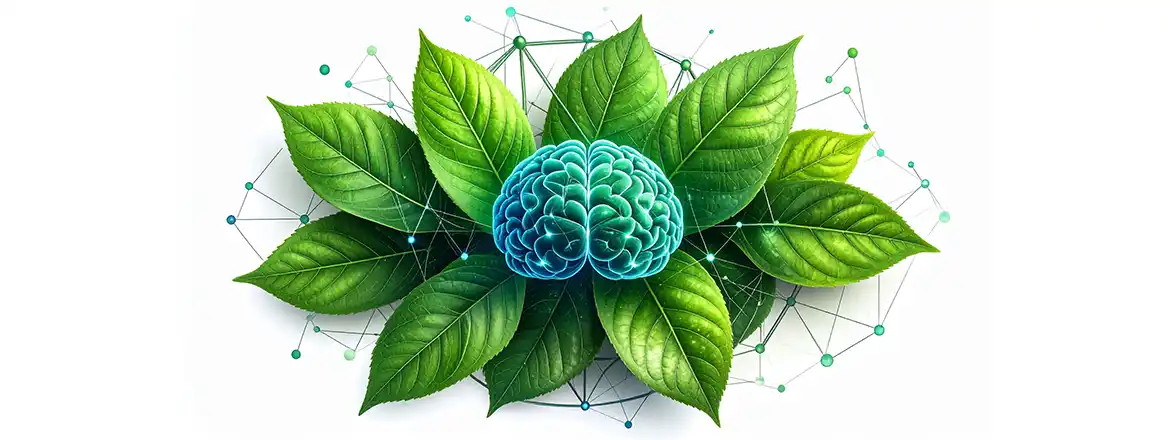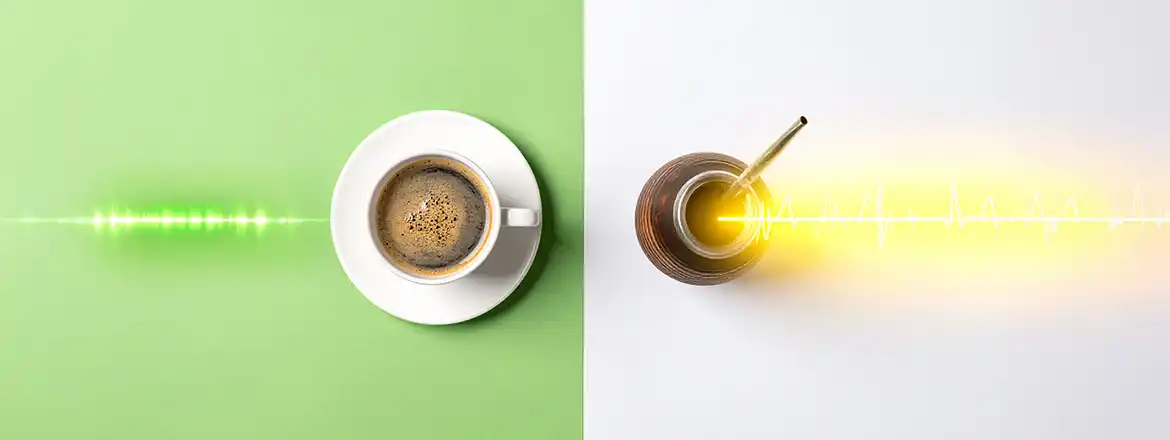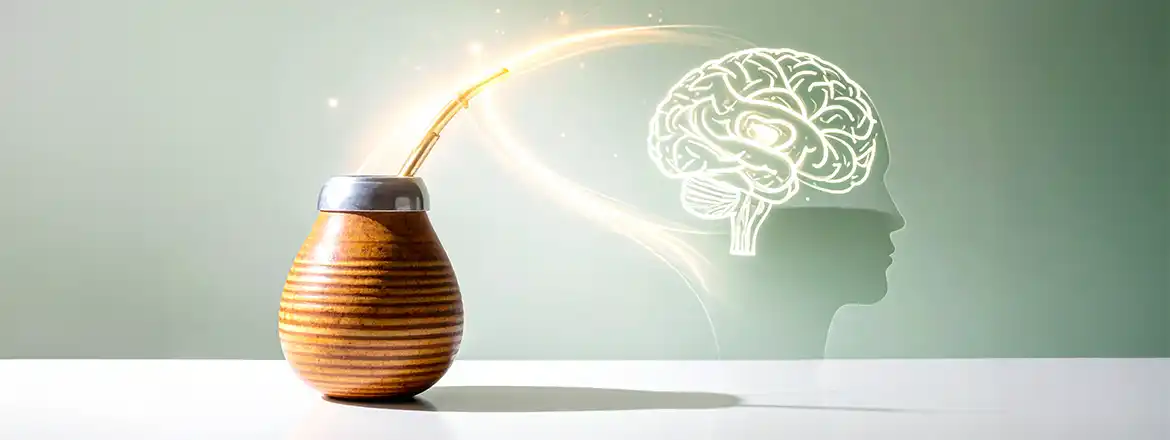Yerba mate and concentration – how does it work and why does it stimulate the mind while studying?

The beginning of the academic year and the first weeks of classes are a time when many students look for ways to study more effectively, prepare for classes and extend their periods of focus. And not only students – also people doing mental work, programmers or freelancers – often wonder: does yerba mate stimulate you as strongly as coffee, or does it work differently?
It’s no coincidence that the topic of yerba mate and studying has become so popular in recent years. More and more people are discovering that this South American herb not only gives you energy but also supports concentration, memory and the process of learning. And what’s more – it does so in a more balanced way than coffee, without a sudden “peak” and a later crash in energy.
In this article, we’ll investigate:
- ➡️ whether yerba mate contains caffeine and how its effect differs from that in coffee or tea,
- ➡️ how does yerba mate work on the brain and nervous system,
- ➡️ which active compounds are responsible for its unique properties,
- ➡️ and we’ll suggest which blends to choose if you want to support your studies, memory and focus.
Summary:
- The chemical composition of yerba mate and its significance for the brain
- Yerba mate and concentration
- Why does yerba mate stimulate and how long does it last?
- How to drink yerba mate for better concentration?
The chemical composition of yerba mate and its significance for the brain
To understand why so many people choose an infusion of Ilex paraguariensis while studying or working, it’s worth looking deeper into its composition. The active compounds contained in yerba mate are responsible for stimulation, improved concentration and greater mental clarity. In short – it’s a natural “brain booster pack” working on multiple levels, from a quick energy lift to protection of the nervous system against oxidative stress.
Interestingly, yerba mate contains not one but an entire set of active substances – and it’s this synergy that makes the infusion work differently from coffee or traditional tea. The best-known substance is, of course, caffeine, but equally important are theobromine, theophylline and polyphenols, which modify its effect and make yerba mate stimulate more gently yet for longer. This is why it’s increasingly considered the ideal drink for students and people doing mental work.
The composition of yerba mate – caffeine, theobromine, theophylline and polyphenols
Before we move on to the details, it’s worth knowing that each of these ingredients works in a slightly different way. Together they form a unique combination that not only gives you energy but also supports memory, concentration and the general condition of the nervous system.
- 🌿 Caffeine – that’s the answer to the question of whether and why yerba mate stimulates. It’s thanks to caffeine that you feel energised after drinking mate. But yerba acts differently from coffee. The effect doesn’t hit suddenly – it builds up gradually and lasts longer. This means no sudden “crash” after an hour or two, giving a huge advantage during long study sessions or exam periods.
- 🌿 Theobromine – known primarily from dark chocolate, plays the role of a more subtle stimulant in yerba mate. It dilates blood vessels, supports circulation and oxygenation of the brain, creating a sense of lightness, clarity and “mental freshness”.
- 🌿 Theophylline – a compound similar to caffeine but acting more on the respiratory system. It improves oxygen supply to the body, which, as we know, contributes to better mental and physical performance.
- 🌿 Polyphenols (antioxidants) – the natural “protective shield” for nerve cells. They combat free radicals, slow down cell ageing and strengthen the health of the nervous system. They’re one answer to the question “what does drinking yerba do apart from stimulation?” – it provides long-term support for the body!
💡 Fun fact for students and those doing mental work: yerba mate contains on average between 70 and 90 mg of caffeine per serving – roughly the same as a cup of coffee. The difference, however, lies in the presence of theobromine and polyphenols, which make the effect of yerba mate’s caffeine more stable and prolonged. Caffeine in the body has what’s known as a half-life – the time it takes for the concentration of this compound in the blood to reduce by half, usually between four and six hours.
In the case of yerba mate, many people experience the effect as gentler and more even, precisely due to its synergy with other alkaloids. With coffee, the “peak” of stimulation arrives quickly and disappears just as fast. With mate – the energy gradually unfolds and can last for several hours without a sudden feeling of fatigue. That’s why yerba mate works so well for studying, creative work or long sessions of concentration.

Yerba mate and concentration
Concentration is one of the key elements of effective studying, creative work or completing tasks that require focus. It’s no wonder many people ask: does yerba mate stimulate you in a way that truly helps focus? The answer is yes – but it does so more subtly and more steadily than coffee.
Yerba mate doesn’t trigger a sudden surge of energy followed by a rapid drop. Instead, thanks to the synergy of caffeine, theobromine and polyphenols, it provides a longer state of mental alertness. This quality is invaluable during an intense study period, hours of coding or work on a complex creative project.
People who drink yerba often notice:
- 🚀 increased alertness without the nervous jitters that coffee can bring,
- 🧠 greater mental clarity – it’s easier to get into a focused state,
- ⏳ longer-lasting concentration, which in practice means it’s easier to complete larger portions of material without getting distracted.
It’s no surprise that students are increasingly choosing yerba mate as an alternative to multiple cups of coffee per day. Moreover, there are special blends created for learners, where yerba mate is enriched with guarana, ginseng or ginkgo biloba. This combination makes mental stimulation even more comprehensive and long-lasting.
Yerba mate – its effect on memory and the learning process
Stimulation and concentration are one thing – but effective learning also requires good memory. Interestingly, scientific studies link moderate caffeine consumption not only to increased alertness but also to improved short-term and long-term memory. This explains why, after drinking yerba mate or coffee, we often find it easier to memorise new information or recall previously learned material.
The difference lies in the fact that, in the case of yerba mate, the effect is more stable, while additional components – such as polyphenols – strengthen the protection of nerve cells from oxidative stress. You could say that mate tea acts not only temporarily (improving focus during study) but also supports the brain in a broader, long-term sense.
In practice, drinking yerba mate can:
- 📚 support memorisation and associations (short-term memory),
- 📝 aid the consolidation of knowledge and recollection of information over time (long-term memory),
- 🛡️ protect brain cells from oxidative stress thanks to its high antioxidant content,
- 🌱 act as a natural aid to learning processes without the need for synthetic supplements.
💡 Tip: To get the most out of yerba mate while studying, choose blends enriched with natural additives such as guarana, ginseng or ginkgo biloba. These ingredients can further support memory and concentration, creating with yerba a perfect combo for busy study or work periods. On the market, such compositions are often called “Más IQ” or “Más Inteligente”.

Why does mate stimulate and how long does yerba mate last?
Many new fans of Paraguayan holly ask themselves: does yerba mate really stimulate you, why, and does its effect differ from coffee? The answer lies in its unique set of active compounds working together in synergy. It’s this synergy that allows us to answer confidently: yes, yerba mate does stimulate – and it does so not only effectively but also steadily and in the long term!
In coffee, caffeine plays the dominant role; it acts quickly – the effect can be felt in just 15–20 minutes – but the burst of energy fades just as fast. In yerba mate, caffeine is also present, yet its action is “supported” and balanced by theobromine, theophylline and antioxidants. Consequently, yerba mate stimulates more evenly, without that sudden “rush and crash” feeling you may experience with coffee.
Does everyone experience this effect in the same way? Not exactly. The way yerba mate works depends on individual predispositions and tolerance to caffeine. Several factors influence this, such as:
- ☕ Amount of leaves used – the more yerba mate you put into your gourd, the stronger the brew,
- 💧 Brewing method – the longer the leaves are in contact with water, the more caffeine, theobromine and polyphenols are released,
- 🧬 Individual tolerance – people accustomed to coffee or energy drinks might feel the effect more subtly,
- 🕒 Time of day – drinking yerba mate in the evening can make it harder to fall asleep for those sensitive to caffeine.
How long does yerba mate last in practice? It depends, but in most cases, the effects of alertness and stimulation last from three to even six hours. The key factor here is the aforementioned caffeine half-life – averaging four to six hours – as well as the combined influence of theobromine and theophylline, which extend the period of activity within the body. This is why students and professionals increasingly reach for mate tea instead of multiple cups of coffee or artificial energy drinks.
💡 Practical tip: The stimulating effect of yerba mate doesn’t always appear immediately. For many people, it develops gradually and may only become noticeable after several minutes – sometimes even after half an hour. So if you don’t feel an instant “kick of energy”, give yerba mate time! Don’t rush to make another brew – let the infusion do its job slowly, and you’ll appreciate its smoother, longer-lasting result.

How to drink yerba mate for better concentration?
Knowing how does yerba mate work is only half the story. The other half is how to include it in your daily routine so that it supports your studies and work instead of causing overstimulation. It’s worth learning how much to drink, when, and which blends to choose to achieve the best results.
How much yerba mate per day to achieve focus?
For most people, the optimal amount of dried leaves throughout the day is around 20 to 30 g – roughly two-thirds of a standard mate gourd. This amount provides a clear state of alertness and concentration while avoiding side effects such as jitters or trouble sleeping. Naturally, as with coffee, caffeine tolerance is an individual matter – it’s best to start with less and increase gradually to find your perfect balance.
When is the best time to drink yerba mate?
- ✔️ Before studying or lectures – to enter a focused state more easily, especially during morning classes when the brain isn’t fully active yet,
- ✔️ During office or creative work – to maintain stable concentration for several hours,
- ✔️ Before major mental challenges – exams, projects, deadlines – yerba mate helps you keep a clear mind and resist fatigue.
It’s best to avoid drinking yerba mate late in the evening – particularly if you’re sensitive to caffeine. Yerba mate can stimulate at any time of day, even late at night, which might interfere with sleep. Try to limit your last portion to early or mid-afternoon.
What does drinking mate tea do in the long run?
Regularly incorporating yerba mate into your daily routine offers more than a temporary boost in concentration. It also provides:
- ✔️ More sustained energy spread evenly throughout the day,
- ✔️ Better readiness for intellectual effort,
- ✔️ Protection of nerve cells thanks to antioxidants,
- ✔️ Natural support from plant ingredients instead of synthetic supplements or artificial energy drinks.

🚀 Recommendations straight from MateMundo!
Here are several proven suggestions that work brilliantly for studying and mental performance:
- Verde Mate Más IQ – a classic blend with guarana, ginseng, ginkgo biloba, pineapple and orange peel. Perfect for steady energy and mental freshness.
- Verde Mate Más IQ Tropical – an exotic version with papaya, lemon peel and flower petals, ideal for lovers of fruity, tropical notes.
- Guarani Más Inteligente – a strong Paraguayan yerba mate enhanced with guarana, ginseng and ginkgo, created for maximum focus.
- Guarani Ashwagandha Cactus – a unique combination of yerba mate with the adaptogen ashwagandha, ginseng and cactus flower – for those seeking both energy and balance.
- Yaguar Energía Guaraná – an intensely energising yerba mate with guarana and a subtle mango aroma. Ideal before exams or demanding projects.
Yerba mate is more than just an alternative to coffee. Thanks to its unique combination of caffeine, theobromine, theophylline and polyphenols, it energises the mind, enhances concentration and facilitates learning. It’s a natural ally for students, professionals and anyone who wants to perform efficiently without the energy crashes typical of coffee.
If you’re still wondering what the long-term effects of drinking yerba mate are – the answer is simple: steadier energy, improved intellectual performance and overall brain support. Choose your favourite blend and find out for yourself how well yerba mate and learning go together. And if you’re just beginning your mate tea journey – check out our recommendations and pick the one that best suits your lifestyle!
See you soon – may the energy of yerba mate support you in learning and work!
❓ FAQ – Frequently Asked Questions about yerba mate and its impact on concentration and stimulation
1. Does yerba mate stimulate as much as coffee?
2. How long does yerba mate last?
3. Does everyone feel the effects of yerba mate in the same way?
4. What benefits does drinking yerba mate offer when studying?
5. How much yerba should I drink to feel energised but not overdo it?
6. When is the best time to drink yerba mate?
Sources of information:
- Wikipedia: Mate (drink).
- Encyclopædia Britannica: Mate.
- C.I. Heck, E.G. De Mejia, Yerba Mate Tea (Ilex paraguariensis): A Comprehensive Review on Chemistry, Health Implications and Technological Considerations, Journal of Food Science, 2007.




